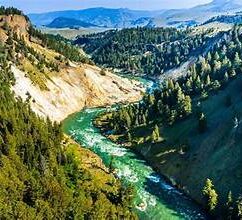No products in the cart.
Yellowstone
Yellowstone brings the drama—this is where bison roam, waterfalls crash, and mountains loom large. And then there’s the geothermal stuff—hot springs, geysers, and boiling mud pots. The most famous is Old Faithful, a geyser that has reliably erupted for decades. Yellowstone is also massive in scope. While it’s located primarily in Wyoming, it extends into Montana and Idaho and has five separate entrances.
You’ll need a vehicle to get the most out of the park, but its sprawling size doesn’t mean you’ll be on your own. In fact, you’ll be joined by more than three million visitors per year. Prepare for traffic jams caused by both humans and wildlife. Luckily, there are plenty of places to rest around the park, including nine lodges and 2,100 campsites. See below for more recs to make the most of your trip.
Things to see and do in Yellowstone
Some things that are worth trying out:
- Grand Canyon of the Yellowstone
- Mystic Falls Trail
- Observation Point Trail
- Early Morning Guided Kayak Tour
Place to Eat:
Typical costs when traveling
A trip to Yellowstone National Park can cost a significant amount, ranging from hundreds to thousands of dollars, depending on the type of lodging, activities, and duration of your stay. Entrance fees, lodging, food, and activities are all factors to consider.
Accommodation:
- Price: $20–$40 per night
- Options: Madison, Canyon, Grant Village, and more
- Tip: Book through Recreation.gov (many fill up months in advance)
Food:
- Restaurants in the Park: Can be expensive, so consider packing some of your own meals.
- Supermarkets Outside the Park: Purchase groceries in nearby towns to save money.
Transportation
- Gas: $3.50–$5.00 per gallon (prices higher in/near the park)
- Car rental: $60–$100/day
- RV rental: $150–$300+/day
- Guided tours (optional): $100–$200+ per day per person
Do’s and Don’ts
In Yellowstone National Park, do stay at least 100 yards from bears and wolves, and 25 yards from other animals, including bison and elk. Don’t feed any animals, even birds and squirrels, or take anything, like plants, from the park’s natural setting. Also, do stay on boardwalks and designated trails, and don’t wander off them.
Do’s:
- Stay at a safe distance from wildlife: Maintain a minimum of 100 yards from bears and wolves, and 25 yards from all other animals, including bison and elk.
- Keep food stored properly: Store food, garbage, and scented items away from wildlife, especially when not in use.
- Stay on trails and boardwalks: Do not wander off designated paths.
- Pack bear spray when hiking: This is an important safety measure in bear country.
- Be aware of the environment: Be cautious around geysers, hot springs, and other potentially dangerous features.
Don’ts:
- Feed wildlife: Never feed any animals, even birds or squirrels, as it can be dangerous for both the animals and visitors.
- Take anything from the park: Do not remove plants, rocks, or any other natural items from the park.
- Litter: Dispose of trash properly and leave the park as you found it.
- Use drones: Drones are generally prohibited within the park.
- Drive under the influence: Never drive while impaired, and ensure all passengers are seated safely.


Leave a Reply